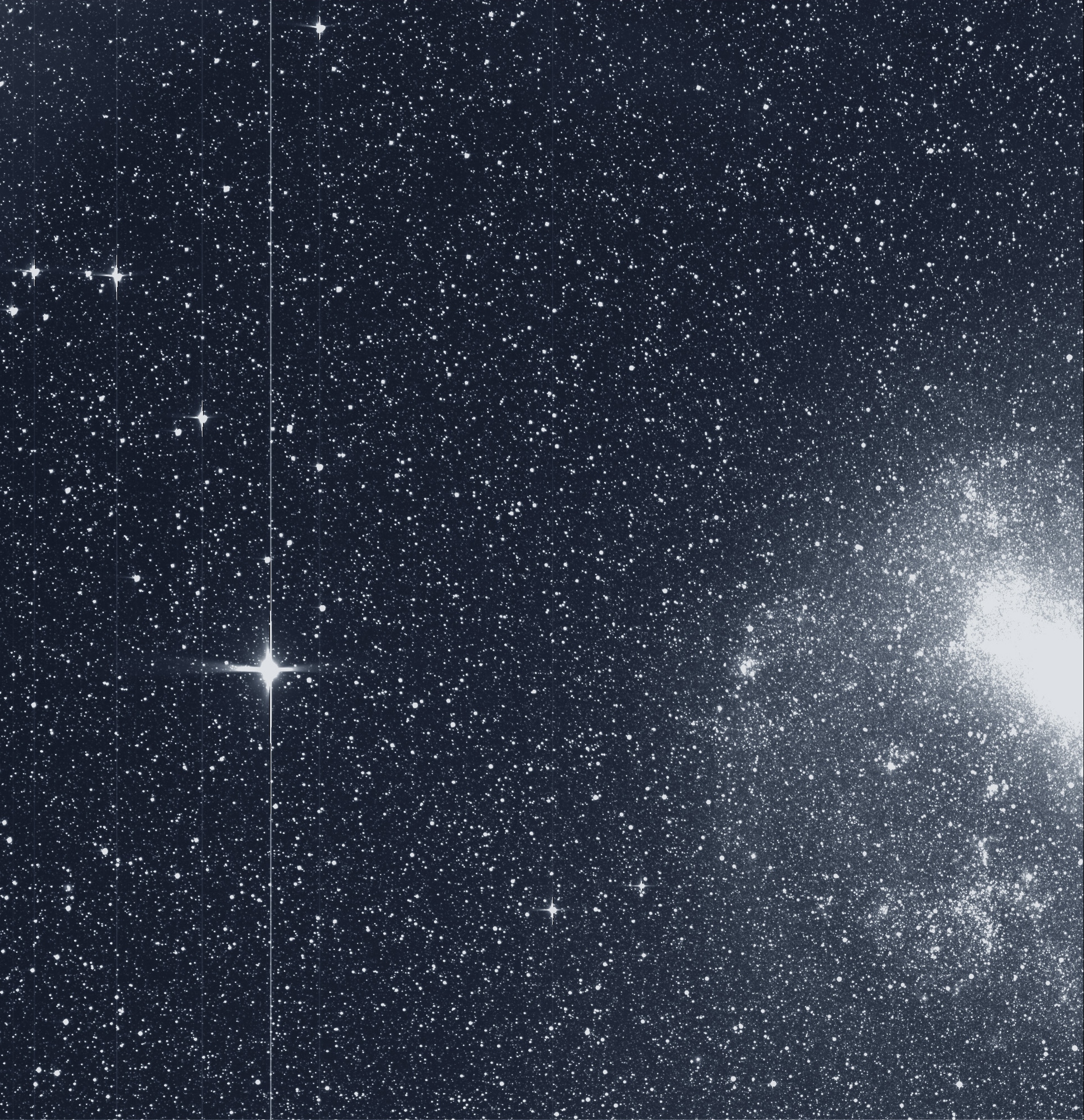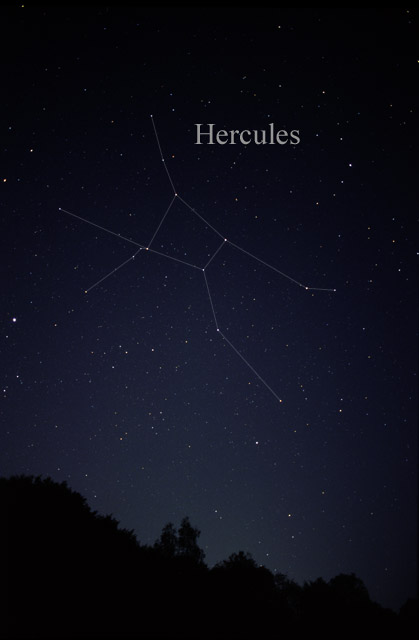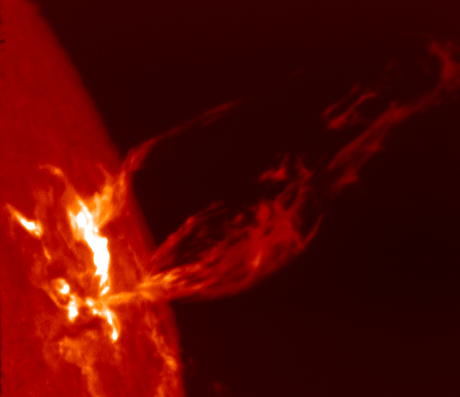|
TOI-2119
TOI-2119 is a binary star system composed of a M-type main sequence star and a brown dwarf, discovered by the Transiting Exoplanet Survey Satellite (TESS) in 2020 and announced in 2022. It became the first example of a brown dwarf orbiting an M-dwarf to have the obliquity of the system measured using the Rossiter–McLaughlin effect. The system is thought to be a field star, not belonging to any identified stellar association or moving group. __TOC__ Observational history The eclipsing binary nature of the system was discovered in the TESS mission data of data sectors 24 and 25, recorded from April through June 2020. In addition to a transit signal with ~7.2-day period of transit depth ''δ'' = , the observed light curve also exhibited stellar flares and a ~13.1-day period brightness modulation which was identified with the rotation period of the star. In addition to the primary eclipse, where the brown dwarf passes in front of the primary star, a secondary eclipse ... [...More Info...] [...Related Items...] OR: [Wikipedia] [Google] [Baidu] |
Transiting Exoplanet Survey Satellite
Transiting Exoplanet Survey Satellite (TESS) is a space telescope for NASA's Explorer program, designed to search for exoplanets using the transit method in an area 400 times larger than that covered by the Kepler mission. It was launched on 18 April 2018, atop a Falcon 9 launch vehicle and was placed into a highly elliptical 13.70-day orbit around the Earth. The first light image from TESS was taken on 7 August 2018, and released publicly on 17 September 2018. In the two-year primary mission, TESS was expected to detect about 1,250 transiting exoplanets orbiting the targeted stars, and an additional 13,000 orbiting stars not targeted but observed. After the end of the primary mission around 4 July 2020, scientists continued to search its data for more planets, while the extended missions acquires additional data. , TESS had identified 7,643 candidate exoplanets, of which 627 had been confirmed. The primary mission objective for TESS was to survey the brightest ... [...More Info...] [...Related Items...] OR: [Wikipedia] [Google] [Baidu] |
Hercules (constellation)
Hercules is a constellation named after Hercules, the Roman mythology hero adapted from the Greek mythology, Greek hero Heracles. Hercules was one of the 48 constellations listed by the second-century astronomer Ptolemy, and it remains one of the IAU designated constellations, 88 modern constellations today. It is the fifth-largest of the modern constellations and is the largest of List of brightest stars, the 50 which have no stars brighter than apparent Magnitude (astronomy), magnitude +2.5. Characteristics Hercules is bordered by Draco (constellation), Draco to the north; Boötes, Corona Borealis, and Serpens, Serpens Caput to the west; Ophiuchus to the south; Aquila (constellation), Aquila to the southwest; and Sagitta, Vulpecula, and Lyra to the east. Covering 1225.1 square degrees and 2.970% of the night sky, it ranks fifth among the 88 constellations in size. The three-letter abbreviation for the constellation, as adopted by the International Astronomical Union in 192 ... [...More Info...] [...Related Items...] OR: [Wikipedia] [Google] [Baidu] |
TESS
Tess or TESS may refer to: Film and theatre * Tess (1979 film), ''Tess'' (1979 film), a 1979 film adaptation of ''Tess of the d'Urbervilles'' * Tess (2016 film), ''Tess'' (2016 film), a South African production Music * Tess (band), a Spanish pop band active from 2000 to 2005 * Tess (musician), a UK musician * Tess Mattisson, a Swedish musician born 1978 Science and technology * Trademark Electronic Search System, a service of the United States Patent and Trademark Office * Transiting Exoplanet Survey Satellite, a space telescope designed to search for extra-solar planets * Ethinylestradiol/cyproterone acetate, a birth control pill * Telescopic Sighting System, a tank/fighter aircraft sight Other uses * Tess (given name) * Various List of storms named Tess, storms named Tess * Nikolay Tess (1921–2006), member of the Soviet Ministry for State Security, convicted in Latvia of mass deportations of Latvians in the 1940s See also * TES (other) {{disambiguation ... [...More Info...] [...Related Items...] OR: [Wikipedia] [Google] [Baidu] |
Effective Temperature
The effective temperature of a body such as a star or planet is the temperature of a black body that would emit the same total amount of electromagnetic radiation. Effective temperature is often used as an estimate of a body's surface temperature when the body's emissivity curve (as a function of wavelength) is not known. When the star's or planet's net emissivity in the relevant wavelength band is less than unity (less than that of a black body), the actual temperature of the body will be higher than the effective temperature. The net emissivity may be low due to surface or atmospheric properties, such as the greenhouse effect. Star The effective temperature of a star is the temperature of a black body with the same luminosity per ''surface area'' () as the star and is defined according to the Stefan–Boltzmann law . Notice that the total ( bolometric) luminosity of a star is then , where is the stellar radius. The definition of the stellar radius is obviously not ... [...More Info...] [...Related Items...] OR: [Wikipedia] [Google] [Baidu] |
Stellar Spectrum
Astronomical spectroscopy is the study of astronomy using the techniques of spectroscopy to measure the spectrum of electromagnetic radiation, including visible light, ultraviolet, X-ray, infrared and radio waves that radiate from stars and other celestial objects. A stellar spectrum can reveal many properties of stars, such as their chemical composition, temperature, density, mass, distance and luminosity. Spectroscopy can show the velocity of motion towards or away from the observer by measuring the Doppler shift. Spectroscopy is also used to study the physical properties of many other types of celestial objects such as planets, nebulae, galaxies, and active galactic nuclei. Background Astronomical spectroscopy is used to measure three major bands of radiation in the electromagnetic spectrum: visible light, radio waves, and X-rays. While all spectroscopy looks at specific bands of the spectrum, different methods are required to acquire the signal depending on the freque ... [...More Info...] [...Related Items...] OR: [Wikipedia] [Google] [Baidu] |
Stellar Magnetic Field
A stellar magnetic field is a magnetic field generated by the motion of conductive plasma inside a star. This motion is created through convection, which is a form of energy transport involving the physical movement of material. A localized magnetic field exerts a force on the plasma, effectively increasing the pressure without a comparable gain in density. As a result, the magnetized region rises relative to the remainder of the plasma, until it reaches the star's photosphere. This creates starspots on the surface, and the related phenomenon of coronal loops. Measurement A star's magnetic field can be measured using the Zeeman effect. Normally the atoms in a star's atmosphere will absorb certain frequencies of energy in the electromagnetic spectrum, producing characteristic dark absorption lines in the spectrum. However, when the atoms are within a magnetic field, these lines become split into multiple, closely spaced lines. The energy also becomes polarized with an orien ... [...More Info...] [...Related Items...] OR: [Wikipedia] [Google] [Baidu] |
Solar Mass
The solar mass () is a frequently used unit of mass in astronomy, equal to approximately . It is approximately equal to the mass of the Sun. It is often used to indicate the masses of other stars, as well as stellar clusters, nebulae, galaxies and black holes. More precisely, the mass of the Sun is The solar mass is about times the mass of Earth (), or times the mass of Jupiter (). History of measurement The value of the gravitational constant was first derived from measurements that were made by Henry Cavendish in 1798 with a torsion balance. The value he obtained differs by only 1% from the modern value, but was not as precise. The diurnal parallax of the Sun was accurately measured during the transits of Venus in 1761 and 1769, yielding a value of (9 arcseconds, compared to the present value of ). From the value of the diurnal parallax, one can determine the distance to the Sun from the geometry of Earth. The first known estimate of the solar mass was by ... [...More Info...] [...Related Items...] OR: [Wikipedia] [Google] [Baidu] |
M Dwarf
A red dwarf is the smallest kind of star on the main sequence. Red dwarfs are by far the most common type of fusing star in the Milky Way, at least in the neighborhood of the Sun. However, due to their low luminosity, individual red dwarfs are not easily observed. Not one star that fits the stricter definitions of a red dwarf is visible to the naked eye. Proxima Centauri, the star nearest to the Sun, is a red dwarf, as are fifty of the sixty nearest stars. According to some estimates, red dwarfs make up three-quarters of the fusing stars in the Milky Way. The coolest red dwarfs near the Sun have a surface temperature of about and the smallest have radii about 9% that of the Sun, with masses about 7.5% that of the Sun. These red dwarfs have spectral types of L0 to L2. There is some overlap with the properties of brown dwarfs, since the most massive brown dwarfs at lower metallicity can be as hot as and have late M spectral types. Definitions and usage of the term "red dwar ... [...More Info...] [...Related Items...] OR: [Wikipedia] [Google] [Baidu] |
Stellar Classification
In astronomy, stellar classification is the classification of stars based on their stellar spectrum, spectral characteristics. Electromagnetic radiation from the star is analyzed by splitting it with a Prism (optics), prism or diffraction grating into a spectrum exhibiting the Continuum (spectrum), rainbow of colors interspersed with spectral lines. Each line indicates a particular chemical element or molecule, with the line strength indicating the abundance of that element. The strengths of the different spectral lines vary mainly due to the temperature of the photosphere, although in some cases there are true abundance differences. The ''spectral class'' of a star is a short code primarily summarizing the ionization state, giving an objective measure of the photosphere's temperature. Most stars are currently classified under the Morgan–Keenan (MK) system using the letters ''O'', ''B'', ''A'', ''F'', ''G'', ''K'', and ''M'', a sequence from the hottest (''O'' type) to the cool ... [...More Info...] [...Related Items...] OR: [Wikipedia] [Google] [Baidu] |
Rayleigh Dissipation Function
In physics, the Rayleigh dissipation function, named after Lord Rayleigh, is a function used to handle the effects of velocity-proportional frictional forces in Lagrangian mechanics In physics, Lagrangian mechanics is a formulation of classical mechanics founded on the d'Alembert principle of virtual work. It was introduced by the Italian-French mathematician and astronomer Joseph-Louis Lagrange in his presentation to the .... It was first introduced by him in 1873. If the frictional force on a particle with velocity \vec can be written as \vec_f = -k\vec, where k is a diagonal matrix, then the Rayleigh dissipation function can be defined for a system of N particles as :R(v) = \frac \sum_^N ( k_x v_^2 + k_y v_^2 + k_z v_^2 ). This function represents half of the rate of energy dissipation of the system through friction. The force of friction is negative the velocity gradient of the dissipation function, \vec_f = -\nabla_v R(v), analogous to a force being equal to the negati ... [...More Info...] [...Related Items...] OR: [Wikipedia] [Google] [Baidu] |
Tidal Deceleration
Tidal acceleration is an effect of the tidal forces between an orbiting natural satellite (e.g. the Moon) and the primary planet that it orbits (e.g. Earth). The acceleration causes a gradual recession of a satellite in a prograde orbit (satellite moving to a higher orbit, away from the primary body, with a lower orbital velocity and hence a longer orbital period), and a corresponding slowdown of the primary's rotation. See supersynchronous orbit. The process eventually leads to ''tidal locking'', usually of the smaller body first, and later the larger body (e.g. theoretically with Earth-Moon system in 50 billion years). The Earth–Moon system is the best-studied case. The similar process of tidal deceleration occurs for satellites that have an orbital period that is shorter than the primary's rotational period, or that orbit in a retrograde direction. These satellites will have a higher and higher orbital velocity and a shorter and shorter orbital period, until a final coll ... [...More Info...] [...Related Items...] OR: [Wikipedia] [Google] [Baidu] |
Tidal Circularization
Tidal circularization is an effect of the tidal forces between a body in orbit around a central celestial object, whereby the eccentricity of the orbit is reduced over time so that it becomes less and less elliptical. Typical situation In Figure 1, consider two stars, denoted Body 1 and Body 2. Initially think of Body 2 as a point mass. The gravity from Body 2 applied to Body 1 produces tidal bulges (see Tidal Force). Let's assume the orbital period is slower than the rotation of Body 1 (ω Ω, the lag angle will be in the other direction. For a star we can think of inelasticity as viscosity. The main cause of inelasticity in a star seems to be convection forces inside the star. When the lag angle is non zero as in figure 1, the forces F1 and F2 combine to produce clockwise torque on body 1, because F1 is stronger. At the same time they torque the orbital motion counter clockwise: if you ignore the portion of F1 and F2 that lie along the line connecting the two bodies t ... [...More Info...] [...Related Items...] OR: [Wikipedia] [Google] [Baidu] |






